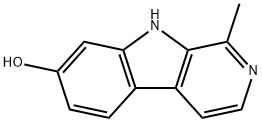Harmol (10-40 mg/kg, orally, twice a day for one month) can improve motor deficits, including movement and coordination, in an α-syn transgenic mouse model. It reduces α-syn levels in the substantia nigra and prefrontal cortex and enhances autophagy-mediated degradation of protein aggregates[1].
Harmol (100 mg/kg, administered by gavage, once daily for three weeks) has a mild anxiety-reducing effect in mice[4].
Harmol (100 mg/kg, orally, for three months) improves insulin, glucose homeostasis, and metabolic adaptations in obese mice, with no impact on kidney function[4].
Harmol (15 μg/kg, orally, from day 0 to 50) extends the lifespan of invertebrates[4].
Harmol (100 mg/kg, orally, for two months) delays frailty in aging mice[4].
| Animal Model: | A53T α-syn mice[1] |
| Dosage: | 10, 20, 40 mg/kg; twice a day; one month |
| Administration: | i.g. |
| Result: | Made mice climb the rod faster, spent more time on the spinning rod, travelled farther in open areas, increased their step frequency and standing posture, reduced posture width, stride, step length, swing, and showed recovery of autonomous movement behavior.
Reduced the expression of α-syn and p62 in the brain’s substantia nigra and prefrontal cortex.
Increased the phosphorylation levels of AMPK Thr172 and TFEB in the substantia nigra, while decreasing the phosphorylation level of mTOR Ser2448.Increased the expression of LC3B-II/LC3B-I, LAMP1, pro-CTSD, and mature ctsd in the substantia nigra, while reducing the expression of p62 and p-ULK1(Ser757)/ULK1. |
| Animal Model: | Male mice[4] |
| Dosage: | 100 mg/kg, single dose; 100 mg/kg, daily, 3 weeks |
| Administration: | i.g. |
| Result: | Showed no change in blood glucose levels, with no change in fasting-mediated ketone body increase, and low permeability of the blood-brain barrier. High levels in the liver and plasma, but low levels in the brain. The mitochondrial autophagy marker PINK1 was elevated, while the phosphorylation levels of AMPK target ACC1 or the autophagy marker LC3-II/LC3-I were unaffected.
Showed no change in the time mice spent in the aversive area (center) versus the non-aversive area (border), with no differences in elevated plus maze tests, and significantly less time spent in the dark/light box.
Increased phosphorylation of ACC2 in the liver and BAT, and levels of the mitochondrial autophagy marker PINK1 were also significantly elevated in the liver, BAT, and soleus. |
| Animal Model: | HFD-fed obese mice[4] |
| Dosage: | 100 mg/kg, 3 months |
| Administration: | Oral |
| Result: | Reduced the increase in mouse weight, decreased water intake, reduced fat levels, without causing weight loss, lowered fasting blood sugar levels, improved glucose tolerance, and improved insulin resistance without affecting insulin sensitivity. Energy expenditure and oxygen consumption decreased, respiratory quotient remained unchanged, and there were no changes in physical activity. There was less fatty liver, lighter liver weight, and significantly higher levels of serum adiponectin and spermidine in the liver. |
| Animal Model: | Nematodes[4] |
| Dosage: | 15 mg/ml; 0, 10, 20, 30, 40, 50 days |
| Administration: | Oral |
| Result: | Reduced AMPK phosphorylation levels, but not significantly, and extent lifespan. |
| Animal Model: | 2-year-old mice[4] |
| Dosage: | 100 mg/mL, two months |
| Administration: | Oral |
| Result: | Lowered fasting blood sugar, reduced total blood cholesterol, allowed for better coordination during exercise for a longer time, maintained grip strength over time, improved muscle strength, enhanced cardiovascular fitness, produced less lactic acid, and increased total myosin heavy chains. |
